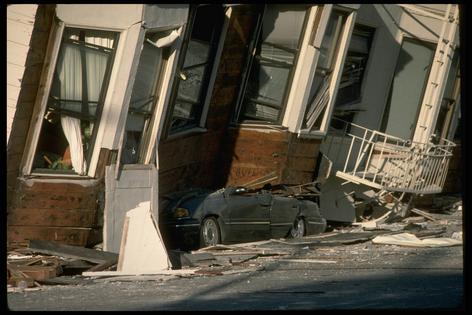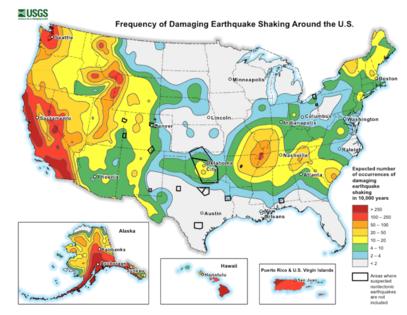US earthquake safety relies on federal employees’ expertise
Published in Science & Technology News
Earthquakes and the damage they cause are apolitical. Collectively, we either prepare for future earthquakes or the population eventually pays the price. The earthquakes that struck Myanmar on March 28, 2025, collapsing buildings and causing over 2,000 deaths, were a sobering reminder of the risks and the need for preparation.
In the U.S., this preparation hinges in large part on the expertise of scientists and engineers in federal agencies who develop earthquake hazard models and contribute to the creation of building codes designed to ensure homes, high-rises and other structures won’t collapse when the ground shakes.
Local communities and states decide whether to adopt building code documents. But those documents and other essential resources are developed through programs supported by federal agencies working in partnership with practicing engineers and earthquake experts at universities.
This essential federal role is illustrated by two programs that we work closely with as an earthquake engineer and a disaster management expert whose work focuses on seismic risk.
First, seismologists and earthquake engineers at the U.S. Geological Survey, or USGS, produce the National Seismic Hazard Model. These maps, based on research into earthquake sources such as faults and how seismic waves move through the earth’s crust, are used to determine the forces that structures in each community should be designed to resist.
A steering committee of earthquake experts from the private sector and universities works with USGS to ensure that the National Seismic Hazard Model implements the best available science.
Second, the Federal Emergency Management Agency, FEMA, supports the process for periodically updating building codes. That includes supporting the work of the National Institute of Building Sciences’ Provisions Update Committee, which recommends building code revisions based on investigations of earthquake damage.
More broadly, FEMA, the USGS, the National Institute of Standards and Technology and the National Science Foundation work together through the National Earthquake Hazards Reduction Program to advance earthquake science and turn knowledge of earthquake risks into safer standards, better building design and education. Some of those agencies have been threatened by potential job and funding cuts under the Trump administration, and others face uncertainty regarding continuation of federal support for their work.
It is in large part because of the National Seismic Hazard Model and regularly updated building codes that U.S. buildings designed to meet modern code requirements are considered among the safest in the world, despite substantial seismic hazards in several states.
This paradigm has been made possible by the technical expertise and lack of political agendas among the federal staff. Without that professionalism, we believe experts from outside the federal government would be less likely to donate their time.
The impacts of these and other programs are well documented. We can point to the limited fatalities from U.S. earthquakes such as the 1989 Loma Prieta earthquake near San Francisco, the 1994 Northridge earthquake in Los Angeles and the 2001 Nisqually earthquake near Seattle. Powerful earthquakes in countries lacking seismic preparedness, often due to lack of adoption or enforcement of building codes, have produced much greater devastation and loss of life.
These programs and the federal agencies supporting them have benefited from a high level of staff expertise because hiring and advancement processes have been divorced from politics and focused on qualifications and merit.
This has not always been the case.
For much of early U.S. history, federal jobs were awarded through a patronage system, where political loyalty determined employment. As described in “The Federal Civil Service System and The Problem of Bureaucracy,” this system led to widespread corruption and dysfunction, with officials focused more on managing quid pro quo patronage than governing effectively. That peaked in 1881 with President James Garfield’s assassination by Charles Guiteau, a disgruntled supporter who had been denied a government appointment.
The passage of the Pendleton Act by Congress in 1883 shifted federal employment to a merit-based system. This preference for a merit-based system was reinforced in the Civil Service Reform Act of 1978. It states as national policy that “to provide the people of the United States with a competent, honest, and productive workforce … and to improve the quality of public service, Federal personnel management should be implemented consistent with merit system principles.”
The shift away from a patronage system produced a more stable and efficient federal workforce, which has enabled improvements in many critical areas, including seismic safety and disaster response.
While the work of these federal employees often goes unnoticed, the benefits are demonstrable and widespread. That becomes most apparent when disasters strike and buildings that meet modern code requirements remain standing.
A merit-based civil service is not just a democratic ideal but a proven necessity for the safety and security of the American people, one we hope will continue well into the future. This can be achieved by retaining federal scientists and engineers and supporting the essential work of federal agencies.
This article is republished from The Conversation, a nonprofit, independent news organization bringing you facts and trustworthy analysis to help you make sense of our complex world. It was written by: Jonathan P. Stewart, University of California, Los Angeles and Lucy Arendt, St. Norbert College
Read more:
If FEMA didn’t exist, could states handle the disaster response on their own?
Acapulco was built to withstand earthquakes, but not Hurricane Otis’ destructive winds – how building codes failed this resort city
What causes earthquakes? A geologist explains where they’re most common and why
Jonathan P. Stewart has received funding from NSF and USGS. He is the chair of the Steering Committee for the National Seismic Hazard Model, a member of the National Institute of Building Sciences' Provisions Update Committee, and a member of the federal Advisory Committee for Earthquake Hazard Reduction (ACEHR). His contributions to this article draw upon his experience and do not reflect the views of the Steering Committee, Provisions Update Committee, or ACEHR.
Lucy Arendt has received funding from NSF and the Applied Technology Council. She is a member and current chair of the federal Advisory Committee for Earthquake Hazard Reduction (ACEHR). Her contributions to this article reflect her professional expertise and do not reflect the views of ACEHR.











Comments